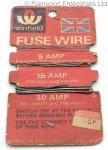junkhound
Senior Member
- Location
- Renton, WA
- Occupation
- EE, power electronics specialty
Electrical service provided in 1914, linen insulated wires pulled thru existing gas pipes where possible for lighting, otherwise K&T.
There were 2 of these 'fuse blocks' using solder for fuse element. 4 outlets in the entire house until the 1950's.
This block replaced in 1950's with Edison base fuse block (my first residential 'job').
One space between studs was lined with asbestos cloth and the 'fuse block' mounted on an asbestos cloth covered wood block.
Times sure have changed.

There were 2 of these 'fuse blocks' using solder for fuse element. 4 outlets in the entire house until the 1950's.
This block replaced in 1950's with Edison base fuse block (my first residential 'job').
One space between studs was lined with asbestos cloth and the 'fuse block' mounted on an asbestos cloth covered wood block.
Times sure have changed.





